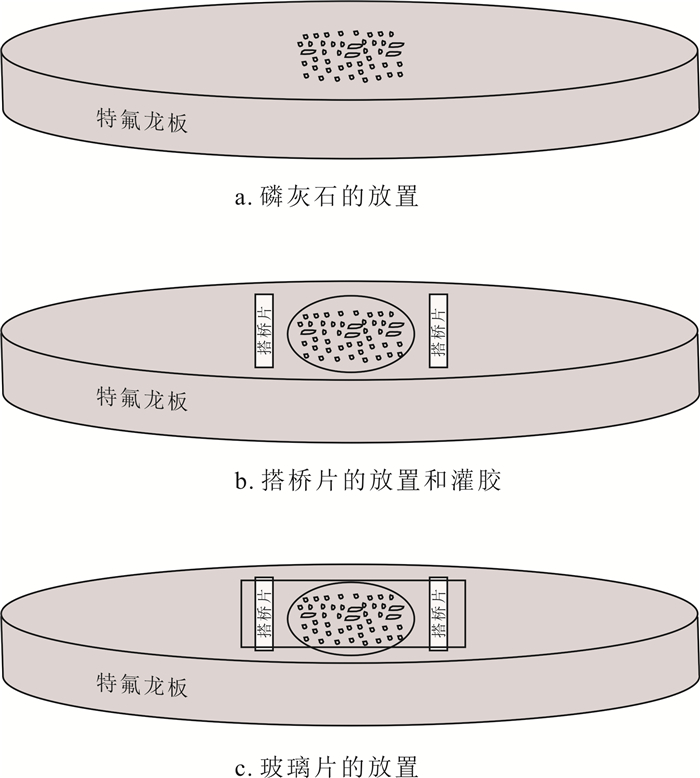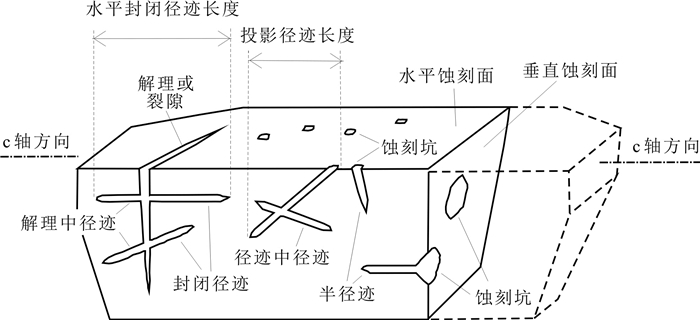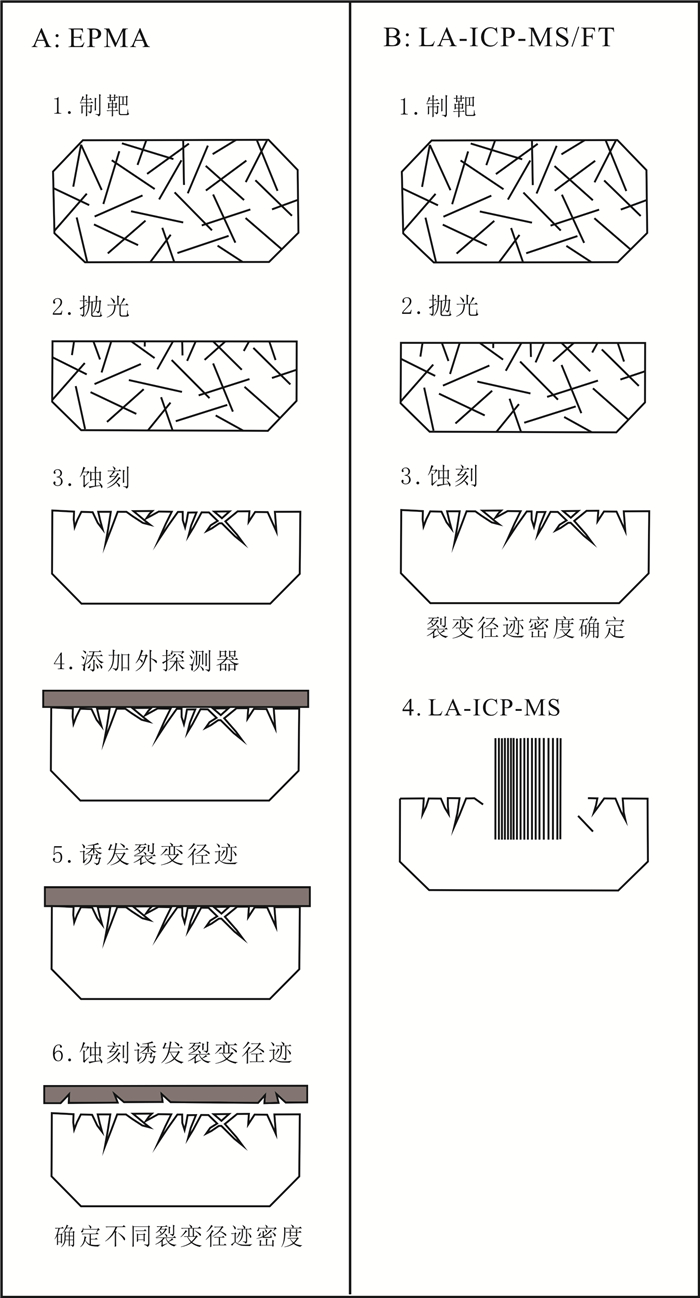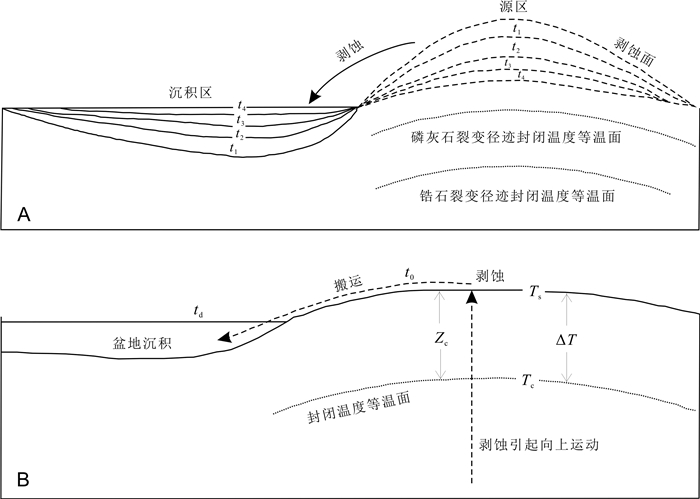PRINCIPLE, EXPERIMENTAL PROCESS AND APPLICATION OF FISSION TRACK LA-ICP-MS/FT METHOD
-
摘要:
裂变径迹是一种重要的低温热年代学测年方法,目前被广泛应用于岩体冷却年龄测试及各种构造演化热历史等的研究.该方法主要包括传统的外探测器法和近年来新开发的激光-电感耦合等离子质谱法(LA-ICP-MS/FT).由于传统的外探测器法一直受限于国内反应堆中子热化不充分、辐照周期长以及辐照带来的环境安全等问题,无法有效、快速地获得数据.相反,LA-ICP-MS/FT法的建立和应用不仅避免了因中子热化不充分、热中子分布不均带入的误差而提高了测年精度,而且还极大地提高了测试效率,缩短了解决科学问题的时间.通过对近年来新建立的裂变径迹LA-ICP-MS/FT法的测年基本原理和方法、实验步骤、常用年龄值和裂变径迹退火等的详细介绍,综述了该方法在相关应用方面的研究进展,并与传统的外探测器法进行了详细的对比.最后综述了LA-ICP-MS/FT法在造山带冷却隆升历史、沉积盆地分析、盆-山耦合系统分析、断裂活动、成矿时代和矿体保存等多方面的应用.
-
关键词:
- 低温年代学 /
- 裂变径迹 /
- LA-ICP-MS/FT法 /
- 造山带 /
- 沉积盆地
Abstract:Fission track, an important low-temperature thermochronology dating method, is widely used in rock mass cooling age tests and study of thermal history of tectonic evolution. It mainly includes the traditional external detector (EPMA) method and newly-developed LA-ICP-MS/FT method. Due to the limitations of traditional method, such as inadequate neutron thermalization in domestic reactors, long irradiation period and environmental security problems, data cannot be obtained effectively and quickly. On the contrary, the establishment and application of LA-ICP-MS/FT not only avoids the errors caused by inadequate neutron thermalization and uneven thermal neutron distribution, but also greatly improves the testing efficiency and shortens the time to solve scientific problems. Through the detailed introduction to fission track LA-ICP-MS/FT dating principle and method, experimental process, commonly-used age value and fission track annealing, the paper discusses the research progress of the method in related applications and compares with traditional external detector method, and finally summarizes the applications in analyses of cooling and uplift history of orogenic belts, sedimentary basins, basin-mountain coupling system, fault activities, metallogenic age and orebody preservation.
-
Key words:
- low-temperature thermochronology /
- fission track /
- LA-ICP-MS/FT /
- orogenic belt /
- sedimentary basin
-

-
图 1 裂变径迹形成模式图 (据文献[1])
Figure 1.
图 3 与矿物表面夹角不同的裂变径迹形成的不同蚀刻形态 (据文献[22])
Figure 3.
图 4 蚀刻后不同形态的裂变径迹 (据文献[25])
Figure 4.
图 5 外探测器法和LA-ICP-MS/FT的实验流程简图 (据文献[28])
Figure 5.
图 6 盆-山耦合关系图解(A)和裂变径迹年龄分析图(B) (据文献[40])
Figure 6.
表 1 外探测器法与LA-ICP-MS/FT法的测试手段对比
Table 1. Comparison between EPMA and LA-ICP-MS/FT methods
测试分析方法 外探测器法 LA-ICP-MS/FT法 样品前处理 复杂 简单处理 热中子照射 需要 不需要 蚀刻云母片与铀玻璃 需要 不需要 裂变径迹选数 自发,诱发,铀玻璃径迹 自发裂变径迹 径迹长度与Dpar值 测试过程相同 测试过程相同 238U/43Ca值 不需要 需要 测试周期 长,需3~4月 短,需2~3周 -
[1] Fleischer R L, Price P B, Walker R M, et al. Nuclear tracks in solids: Principles and applications[M]. Berkeley: University of California Press, 1975: 1-624.
[2] Green P F, Hurford A J. Thermalneutron dosimetry for fissiontrack dating[J]. Nuclear Tracks and Radiation Measurements (1982), 1984, 9(3/4): 231-241. http://www.sciencedirect.com/science/article/pii/0735245X8490190X
[3] 王世成, 康铁笙. 裂变径迹定年中子注量的测量[J]. 原子能科学技术, 1993, 27(2): 152-156. https://www.cnki.com.cn/Article/CJFDTOTAL-YZJS199302007.htm
Wang S C, Kang T S. Thermal neutron fluence measurement for fission track dating[J]. Atomic Energy Science and Technology, 1993, 2(27): 152-156. https://www.cnki.com.cn/Article/CJFDTOTAL-YZJS199302007.htm
[4] Bigazzi G. The problem of the decay constant λf of 238U[J]. Nuclear Tracks, 1981, 5(1/2): 35-44. http://www.onacademic.com/detail/journal_1000034458487810_b8f5.html
[5] Gleadow A J W, Lovering J F. Geometry factor for external detectors in fission track dating[J]. Nuclear Track Detection, 1977, 1(2): 99-106. doi: 10.1016/0145-224X(77)90003-5
[6] Pang J Z, Zheng D W, Wan J L, et al. Insufficient thermalization effects on determining fission-track ages[J]. Science China Earth Sciences, 2013, 56(7): 1233-1241. doi: 10.1007/s11430-012-4471-7
[7] Hasebe N, Barbarand J, Jarvis K, et al. Apatite fission-track chronometry using laser ablation ICP-MS[J]. Chemical Geology, 2004, 207(3/4): 135-145. http://www.sciencedirect.com/science/article/pii/S0009254104000427
[8] Hasebe N, Carter A, Hurford A J, et al. The effect of chemical etching on LA-ICP-MS analysis in determining uranium concentration for fission-track chronometry[J]. Geological Society, London, Special Publications, 2009, 324(1): 37-46. doi: 10.1144/SP324.3
[9] Zhang Y Z, Replumaz A, LeloupP H, et al. Cooling history of the Gongga batholith: Implications for the Xianshuihe Fault and Miocene kinematics of SE Xizang[J]. Earth and Planetary Science Letters, 2017, 465: 1-15. doi: 10.1016/j.epsl.2017.02.025
[10] Deng B, Liu S G, Li Z W, et al. Differential exhumation at eastern margin of the Xizang Plateau, from apatite fission-track thermochr-onology[J]. Tectonophysics, 2013, 591: 98-115. doi: 10.1016/j.tecto.2012.11.012
[11] Jing L Z, Zhang J Y, McPhillips D, et al. Multiple episodes of fast exhumation since Cretaceous in southeast Xizang, revealed by low-temperature thermochronology[J]. Earth and Planetary Science Letters, 2018, 490: 62-76. doi: 10.1016/j.epsl.2018.03.011
[12] Tang Y, Zhang Y P, Tong L L. Mesozoic-Cenozoic evolution of the Zoige depression in the Songpan-Ganzi flysch basin, eastern Xizang Plateau: constraints from detrital zircon U-Pb ages and fission-track ages of the Triassic sedimentary sequence[J]. Journal of Asian Earth Sciences, 2018, 151: 285-300. doi: 10.1016/j.jseaes.2017.10.021
[13] 丁汝鑫, 周祖翼, 王玮. 利用低温热年代学数据计算造山带剥露速率[J]. 地球科学进展, 2007, 22(5): 447-455. doi: 10.3321/j.issn:1001-8166.2007.05.002
Ding R X, Zhou Z Y, Wang W. Modeling exhumation rates of orogenic belts with low-temperature thermochronological data[J]. Advances in Earth Science, 2007, 22(5): 447-455. doi: 10.3321/j.issn:1001-8166.2007.05.002
[14] 胡迪, 沈传波, 刘泽阳. 川东北地区埋藏-剥露历史分析——来自盆地模拟和热年代的制约[J]. 大地构造与成矿学, 2016, 40(6): 1145-1153. https://www.cnki.com.cn/Article/CJFDTOTAL-DGYK201606004.htm
Hu D, Shen C B, Liu Z Y. Basin modeling and thermochronological constrains on the burial and denudational history of the northeast Sichuan Basin[J]. Geotectonica et Metallogenia, 2016, 40(6): 1145-1153. https://www.cnki.com.cn/Article/CJFDTOTAL-DGYK201606004.htm
[15] 李振华, 陈刚, 丁超, 等. 碎屑颗粒裂变径迹热年代学在沉积物源区剥露历史分析中的应用[J]. 地质科技情报, 2012, 31(2): 19-26. doi: 10.3969/j.issn.1000-7849.2012.02.003
Li Z H, Chen G, Ding C, et al. Application of detrital grain thermochronology on the exhumation history of the source areas[J]. Geological Science and Technology Information, 2012, 31(2): 19-26. doi: 10.3969/j.issn.1000-7849.2012.02.003
[16] 刘武生, 秦明宽, 漆富成, 等. 运用磷灰石裂变径迹分析鄂尔多斯盆地周缘中新生代沉降隆升史[J]. 铀矿地质, 2008, 24(4): 221-227, 232. doi: 10.3969/j.issn.1000-0658.2008.04.006
Liu W S, Qin M K, Qi F C, et al. Analysis on the Meso-Neozoic subsidence and uplift history of the periphery of Ordos Basin using apatite fission track[J]. Uranium Geology, 2008(4): 221-227, 232. doi: 10.3969/j.issn.1000-0658.2008.04.006
[17] 王国灿. 沉积物源区剥露历史分析的一种新途径——碎屑锆石和磷灰石裂变径迹热年代学[J]. 地质科技情报, 2002, 21(4): 35-40. doi: 10.3969/j.issn.1000-7849.2002.04.008
Wang G C. A new approach to determine the exhumation history of the sediment provenance: Detrital zircon and apatite fission-track thermochronology[J]. Geological Science and Technology Information, 2002, 21(4): 35-40. doi: 10.3969/j.issn.1000-7849.2002.04.008
[18] 王世明, 马昌前, 佘振兵, 等. 柴西新生代沉积源区及盆地热历史的磷灰石裂变径迹分析[J]. 地质科技情报, 2008, 27(5): 29-36. doi: 10.3969/j.issn.1000-7849.2008.05.005
Wang S M, Ma C Q, She Z B, et al. Apatite fission track analyses of Cenozoic sedimentary source and basin thermal history in west Qaidam Basin[J]. Geological Science and Technology Information, 2008, 27(5): 29-36. doi: 10.3969/j.issn.1000-7849.2008.05.005
[19] 邢凯, 舒启海, 赵鹤森, 等. 滇西普朗斑岩铜矿床中磷灰石的地球化学特征及其地质意义[J]. 岩石学报, 2018, 34(5): 1427-1440. https://www.cnki.com.cn/Article/CJFDTOTAL-YSXB201805015.htm
Xing K, Shu Q H, Zhao H S, et al. Geochemical characteristics and geological significance of apatites in the Pulang porphyry copper deposit, NW Yunnan Province[J]. Acta Petrologica Sinica, 2018, 34(5): 1427-1440. https://www.cnki.com.cn/Article/CJFDTOTAL-YSXB201805015.htm
[20] 张丽婷, 袁万明, 李娜, 等. 甘孜-理塘金成矿带构造活动的磷灰石裂变径迹年代学制约[J]. 岩石学报, 2015, 31(11): 3353-3362. https://www.cnki.com.cn/Article/CJFDTOTAL-YSXB201511013.htm
Zhang L T, Yuan W M, Li N, et al. Apatite fission track constrains on tectonic activities in Ganzi-Litang gold belt, Qinghai-Xizang Plateau[J]. Acta Petrologica Sinica, 2015, 31(11): 3353-3362. https://www.cnki.com.cn/Article/CJFDTOTAL-YSXB201511013.htm
[21] Donelick R A, O'Sullivan PB, Ketcham R A. Apatite fission-track analysis[J]. Reviews in Mineralogy and Geochemistry, 2005, 58(1): 49-94. doi: 10.2138/rmg.2005.58.3
[22] Fleischer R L, Trower WP. Tracks to innovation: nuclear tracks in science and technology[J]. Physics Today, 1999, 52(3): 84-86. http://ci.nii.ac.jp/ncid/BA35582813
[23] Barbarand J, Carter A, Wood I, et al. Compositional and structural control of fission-track annealing in apatite[J]. Chemical Geology, 2003, 198(1/2): 107-137. http://www.sciencedirect.com/science/article/pii/S0009254102004242
[24] Carlson W D, Donelick R A, Ketcham R A. Variability of apatite fission-track annealing kinetics: I. Eexperimental results[J]. American Mineralogist, 1999, 84(9): 1213-1223. doi: 10.2138/am-1999-0901
[25] Malusà M G, Fitzgerald P G. Fission-track thermochronology and its application to geology[M]. Cham: Springer, 2019: 1-373.
[26] Vermeesch P. Statistics for LA-ICP-MS based fission track dating[J]. Chemical Geology, 2017, 456: 19-27. doi: 10.1016/j.chemgeo.2017.03.002
[27] Vermeesch P, Tian Y T. Thermal history modelling: HeFTy vs. QTQt[J]. Earth-Science Reviews, 2014, 139: 279-290. doi: 10.1016/j.earscirev.2014.09.010
[28] Tagami T, O'Sullivan P B. Fundamentals of fission-track thermochr-onology[J]. Reviews in Mineralogy and Geochemistry, 2005, 58(1): 19-47. doi: 10.2138/rmg.2005.58.2
[29] 刘海青, 李荣西, 张艳妮, 等. 磷灰石裂变径迹在确定造山带隆升速率中的应用[J]. 西北地质, 2014, 47(2): 119-125. doi: 10.3969/j.issn.1009-6248.2014.02.013
Liu H Q, Li R X, Zhang Y N, et al. The application of apatite fission track in determining the tectonic uplift rates[J]. Northwestern Geology, 2014, 47(02): 119-125. doi: 10.3969/j.issn.1009-6248.2014.02.013
[30] 余梦丽. 裂变径迹方法及其在造山带隆升中的应用[J]. 化学工程与装备, 2017(12): 93-94, 102. https://www.cnki.com.cn/Article/CJFDTOTAL-FJHG201712030.htm
Yu M L. Fission track method and its application in orogenic uplift[J]. Chemical Engineering & Equipment, 2017, 46(12): 93-94. (in Chinese) https://www.cnki.com.cn/Article/CJFDTOTAL-FJHG201712030.htm
[31] 张世平. 裂变径迹方法及其在造山带隆升中的应用[J]. 化工管理, 2018(11): 15-16. doi: 10.3969/j.issn.1008-4800.2018.11.011
Zhang S P. Fission track method and its application in orogenic uplift[J]. Chemical Enterprise Management, 2018(11): 15-16. (in Chinese) doi: 10.3969/j.issn.1008-4800.2018.11.011
[32] 葛玉魁. 冈底斯造山带新生代以来剥露历史的热年代学约束及沉积响应[D]. 北京: 中国地质大学, 2016.
Ge Y K. The Exhumation history of the Gangdese batholith from low temperature thermochronology and sedimentay response[D]. Beijing: China University of Geosciences, 2016.
[33] 赵富远. 胶东三佛山早白垩世花岗岩磷灰石、锆石裂变径迹研究[D]. 北京: 中国地质大学, 2015.
Zhao F Y. Study on apatite and zircon fission-track of Early Cretaceous granite of Sanfoshan in Jiaodong[D]. Beijing: China University of Geosciences, 2015.
[34] Dodson M H. Closure temperature in cooling geochronological and petrological systems[J]. Contributions to Mineralogy and Petrology, 1973, 40(3): 259-274. doi: 10.1007/BF00373790
[35] Galbraith R F. The radial plot: graphical assessment of spread in ages[J]. International Journal of Radiation Applications and Instrumentation. Part D. Nuclear Tracks and Radiation Measurements, 1990, 17(3): 207-214. doi: 10.1016/1359-0189(90)90036-W
[36] Brandon M T. Decomposition of fission-track grain-age distributions[J]. American Journal of Science, 1992, 292(8): 535-564. doi: 10.2475/ajs.292.8.535
[37] 周祖翼, 毛凤鸣, 廖宗廷, 等. 裂变径迹年龄多成分分离技术及其在沉积盆地物源分析中的应用[J]. 沉积学报, 2001, 19(3): 456-458, 473. doi: 10.3969/j.issn.1000-0550.2001.03.024
Zhou Z Y, Mao F M, Liao Z T, et al. Estimation of the multi-component fission track age data and its application in the provenance study of sedimentary basins[J]. Acta Sedimentologica Sinica, 2001, 19(3): 456-458, 473. doi: 10.3969/j.issn.1000-0550.2001.03.024
[38] 王毅, 金之钧. 沉积盆地中恢复地层剥蚀量的新方法[J]. 地球科学进展, 1999, 14(5): 482-486. doi: 10.3321/j.issn:1001-8166.1999.05.010
Wang Y, Jin Z J. Progress of the methods on the recovery of the thickness of eroded stratain basin[J]. Advances in Earth Science, 1999, 14(5): 482-486. doi: 10.3321/j.issn:1001-8166.1999.05.010
[39] 刘树根, 罗志立, 赵锡奎, 等. 中国西部盆山系统的耦合关系及其动力学模式——以龙门山造山带-川西前陆盆地系统为例[J]. 地质学报, 2003, 77(2): 177-186. https://www.cnki.com.cn/Article/CJFDTOTAL-DZXE200302007.htm
Liu S G, Luo Z L, Zhao X K, et al. Coupling relationships of sedimentary basin-orogenic belt systems and their dynamic models in West China: A case study of the Longmenshan orogenic belt-West Sichuan foreland basin system[J]. Acta Geologica Sinica, 2003(2): 177-186. https://www.cnki.com.cn/Article/CJFDTOTAL-DZXE200302007.htm
[40] Garver J I, Brandon M T, Roden-Tice M, et al. Exhumation history of orogenic highlands determined by detrital fission-track thermoc-hronology[J]. Geological Society, London, Special Publications, 1999, 154(1): 283-304. doi: 10.1144/GSL.SP.1999.154.01.13
[41] 陈威威, 何碧竹, 许志琴, 等. 裂变径迹方法约束的塘古兹巴斯坳陷中-新生代热演化史——来自青藏高原构造运动的响应[J]. 岩石学报, 2016, 32(12): 3817-3834. https://www.cnki.com.cn/Article/CJFDTOTAL-YSXB201612017.htm
Chen W W, He B Z, Xu Z Q, et al. The thermal evolution history of Tangguzibas depression in the Meso-Cenozoic based on constraints of fission track method: Manifestation of the tectonic movements in Xizang Plateau[J]. Acta Petrologica Sinica, 2016, 32(12): 3817-3834. https://www.cnki.com.cn/Article/CJFDTOTAL-YSXB201612017.htm
[42] 许立青, 李三忠, 郭玲莉, 等. 郯庐断裂带对鲁西隆升过程的影响: 磷灰石裂变径迹证据[J]. 岩石学报, 2016, 32(4): 1153-1170. https://www.cnki.com.cn/Article/CJFDTOTAL-YSXB201604015.htm
Xu L Q, Li S Z, Guo L L, et al. Impaction of the Tan-Lu Fault Zone on uplift of the Luxi Rise: Constraints from apatite fission track thermochronology[J]. Acta Petrologica Sinica, 2016, 32(4): 1153-1170. https://www.cnki.com.cn/Article/CJFDTOTAL-YSXB201604015.htm
[43] 闵康, 高剑峰, 齐有强, 等. LA-ICP-MS/FT方法在矿床保存研究中的应用——以赣东北德兴铜矿和银山铅锌矿床为例[J]. 大地构造与成矿学, 2019, 44(1): 80-91. https://www.cnki.com.cn/Article/CJFDTOTAL-DGYK202001008.htm
Min K, Gao J F, Qi Y Q, et al. LA-ICP-MS/FT applicationin preservation evaluation of ore deposits-case studies of the Dexing copper deposit and Yinshan Pb-Zn deposit, northeastern Jiangxi Province[J]. Geotectonica et Metallogenia, 2019, 44(1): 80-91. https://www.cnki.com.cn/Article/CJFDTOTAL-DGYK202001008.htm
[44] 杨莉, 袁万明, 王珂. 热年代学方法、技术手段及其在矿床地质中的研究进展[J]. 地球科学, 2018, 43(6): 1887-1902. https://www.cnki.com.cn/Article/CJFDTOTAL-DQKX201806008.htm
Yang L, Yuan W M, Wang K. Research advances of thermoch-ronology in mineral deposits[J]. Earth Science, 2018, 43(6): 1887-1902. https://www.cnki.com.cn/Article/CJFDTOTAL-DQKX201806008.htm
[45] 袁万明. 矿床保存变化研究的热年代学技术方法[J]. 岩石学报, 2016, 32(8): 2571-2578. https://www.cnki.com.cn/Article/CJFDTOTAL-YSXB201608023.htm
Yuan W M. Thermochronological method of revealing conservation and changes of mineral deposits[J]. Acta Petrologica Sinica, 2016, 32(08): 2571-2578. https://www.cnki.com.cn/Article/CJFDTOTAL-YSXB201608023.htm
[46] 周海, 雷川. 磷灰石裂变径迹(AFT)研究进展[J]. 西北地质, 2013, 46(1): 168-177. https://www.cnki.com.cn/Article/CJFDTOTAL-XBDI201301021.htm
Zhou H, Lei C. The study progress in apatite fission track (AFT)[J]. Northwestern Geology, 2013, 46(1): 168-177. https://www.cnki.com.cn/Article/CJFDTOTAL-XBDI201301021.htm
[47] Ketcham R A, Donelick R A, Donelick M B. AFT solve: A program for multi-kinetic modeling of apatite fission-track data[J]. American Mineralogist, 2003, 88(5/6): 929. http://ci.nii.ac.jp/naid/10026542267
[48] Ketcham R A. Forward and inverse modeling of low-temperature thermochronometry data[J]. Reviews in Mineralogy and Geochemistry, 2005, 58(1): 275-314. http://adsabs.harvard.edu/abs/2005RvMG...58..275K
[49] Ketcham R A, Carter A, Donelick R A, et al. Improved modeling of fission-track annealing in apatite[J]. American Mineralogist, 2007, 92(5/6): 799-810. http://www.degruyter.com/view/j/ammin.2007.92.issue-5-6/am.2007.2281/am.2007.2281.xml?format=INT
[50] 田云涛, 袁玉松, 胡圣标. 磷灰石裂变径迹分析新进展[J]. 地球物理学进展, 2009, 24(3): 909-920. https://www.cnki.com.cn/Article/CJFDTOTAL-DQWJ200903014.htm
Tian Y T, Yuan Y S, Hu S B. New progresses in apatite fission track analysis[J]. Progress in Geophysics, 2009, 24(3): 909-920. https://www.cnki.com.cn/Article/CJFDTOTAL-DQWJ200903014.htm
-




 下载:
下载:




